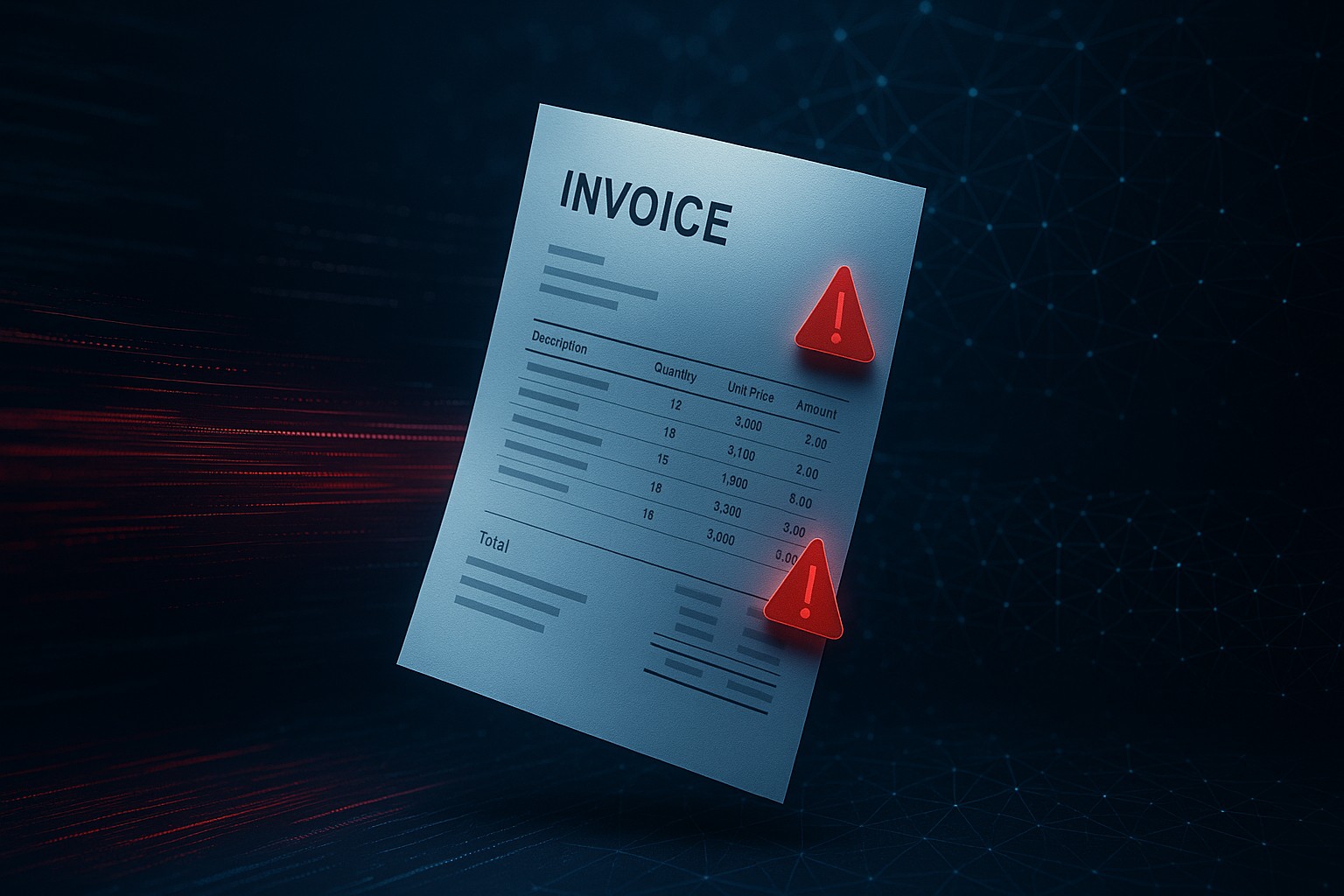In the intricate world of corporate finance, vendor invoices represent a critical yet vulnerable point of entry for fraudulent activities. Traditionally, accounts payable departments have relied on manual reviews and rule-based systems to identify suspicious invoices. However, these methods are often time-consuming, prone to human error, and easily outsmarted by increasingly sophisticated fraudsters. Enter Artificial Intelligence (AI), a game-changing technology that is revolutionizing how businesses detect and prevent invoice fraud. This article delves into the mechanics of AI in invoice fraud detection, exploring its capabilities, benefits, and the future of accounts payable security.
The Growing Threat of Vendor Invoice Fraud
Vendor invoice fraud encompasses a range of deceptive practices aimed at illegally extracting funds from a company through falsified or manipulated invoices. Common types of fraud include:
- Duplicate Invoices: Submitting the same invoice multiple times for payment.
- Fake Invoices: Creating completely fabricated invoices for goods or services never rendered.
- Inflated Invoices: Overcharging for legitimate goods or services by increasing the price or quantity.
- Shell Company Invoices: Setting up a fictitious vendor to submit invoices and siphon off funds.
- Phishing and Business Email Compromise (BEC): Tricking employees into changing vendor payment details to fraudulent accounts.
The consequences of invoice fraud can be significant, ranging from financial losses and reputational damage to legal penalties. As businesses become more global and interconnected, the risk of vendor invoice fraud continues to escalate, making robust detection and prevention measures essential.
How AI Revolutionizes Invoice Fraud Detection
AI offers a powerful arsenal of tools and techniques for detecting and preventing vendor invoice fraud. Unlike traditional methods, AI can analyze vast amounts of data in real-time, identify subtle anomalies, and adapt to evolving fraud schemes. Here’s how AI works in invoice fraud detection:
1. Data Extraction and Processing
The first step involves extracting data from invoices, which can be in various formats, including PDFs, images, and scanned documents. AI invoice fraud detection software utilizes Optical Character Recognition (OCR) to convert these formats into structured data that can be analyzed. Natural Language Processing (NLP) is then used to understand the context and meaning of the text, such as vendor names, invoice numbers, amounts, and descriptions of goods or services.
2. Anomaly Detection
One of the key strengths of AI is its ability to detect anomalies that would be difficult for humans to spot. AI for invoice anomaly detection algorithms learn from historical invoice data to establish a baseline of normal behavior. They then flag any invoices that deviate significantly from this baseline. For example, AI can identify invoices with unusually high amounts, unusual payment terms, or inconsistencies in vendor information.
3. Pattern Recognition
AI can identify patterns and relationships in invoice data that may indicate fraudulent activity. For instance, it can detect duplicate invoices, even if they have slight variations in the invoice number or date. AI can also identify suspicious vendors by analyzing their transaction history, payment patterns, and relationships with other vendors. Detecting duplicate invoices with AI is a critical capability for preventing overpayment and financial losses.
4. Predictive Analysis
AI can use predictive analytics to forecast the likelihood of future fraud. By analyzing historical data and identifying risk factors, AI can generate risk scores for vendors and invoices. This allows accounts payable departments to prioritize their reviews and focus on the highest-risk transactions. How machine learning prevents vendor invoice fraud relies heavily on this predictive capability.
5. Real-time Monitoring
AI enables real-time monitoring of invoice processing, allowing for immediate detection of fraudulent activity. When a suspicious invoice is identified, the AI system can automatically flag it for further review or even halt the payment process. This real-time capability is crucial for preventing fraud before it occurs. Real-time invoice fraud detection is a significant advantage over traditional, reactive methods.
Benefits of AI-Powered Invoice Fraud Detection
The adoption of AI in invoice fraud detection offers numerous benefits for businesses:
- Increased Accuracy: AI algorithms are less prone to human error and can identify subtle anomalies that humans may miss.
- Improved Efficiency: AI automates many of the manual tasks associated with invoice review, freeing up accounts payable staff to focus on more strategic activities.
- Reduced Costs: By preventing fraud and reducing manual review time, AI can significantly reduce costs associated with accounts payable.
- Enhanced Security: AI provides a more robust and proactive defense against fraud, protecting businesses from financial losses and reputational damage.
- Scalability: AI systems can easily scale to handle large volumes of invoices, making them ideal for growing businesses.
Implementing AI for Invoice Fraud Detection
Implementing AI for invoice fraud detection involves several key steps:
- Data Preparation: Clean and organize historical invoice data to train the AI algorithms.
- Algorithm Selection: Choose the appropriate AI algorithms based on the specific fraud risks and data characteristics.
- Model Training: Train the AI models using the prepared data and validate their performance.
- Integration: Integrate the AI system with existing accounts payable systems and workflows.
- Monitoring and Optimization: Continuously monitor the performance of the AI system and optimize it as needed.
The Future of AI in Accounts Payable
As AI technology continues to evolve, its role in accounts payable will only become more prominent. Future advancements in AI will likely lead to even more sophisticated fraud detection capabilities, such as the ability to identify complex fraud schemes involving multiple vendors and transactions. AI-driven invoice analysis will become increasingly sophisticated, enabling businesses to gain deeper insights into their vendor relationships and identify potential risks. Furthermore, the integration of AI with other technologies, such as blockchain, could provide even greater transparency and security in the accounts payable process.
In conclusion, AI is transforming the landscape of invoice fraud detection, offering businesses a powerful and effective way to protect themselves from financial losses and reputational damage. By leveraging the capabilities of AI, accounts payable departments can improve accuracy, efficiency, and security, ensuring the integrity of their financial operations. AI powered fraud prevention for accounts payable is no longer a futuristic concept but a present-day necessity for businesses seeking to thrive in an increasingly complex and challenging environment.
Companies are actively seeking best AI tools for detecting fraudulent invoices and implementing AI vendor risk management invoice fraud solutions to safeguard their financial interests. Embracing AI in accounts payable fraud detection is becoming a standard practice for forward-thinking organizations.
Moreover, the utilization of machine learning for vendor invoice validation and the deployment of automated invoice fraud prevention systems are gaining traction. The ability to use AI to automate invoice auditing processes not only enhances efficiency but also provides a robust defense against sophisticated fraud attempts.
Finally, organizations are exploring AI to identify suspicious vendor invoice activity and enhance their understanding of how AI analysis invoice data to strengthen their overall fraud prevention strategies. These advancements underscore the critical role of AI in modern accounts payable management.








